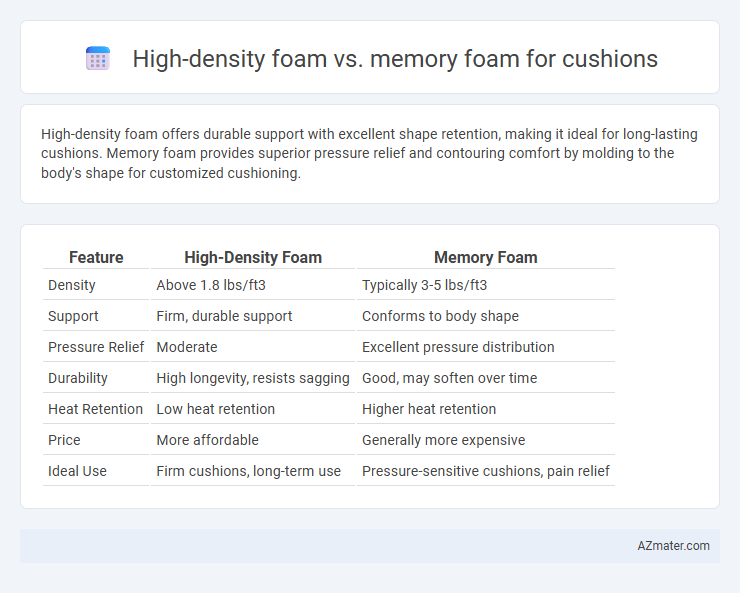High-density foam offers durable support with excellent shape retention, making it ideal for long-lasting cushions. Memory foam provides superior pressure relief and contouring comfort by molding to the body's shape for customized cushioning.
Table of Comparison
| Feature | High-Density Foam | Memory Foam |
|---|---|---|
| Density | Above 1.8 lbs/ft3 | Typically 3-5 lbs/ft3 |
| Support | Firm, durable support | Conforms to body shape |
| Pressure Relief | Moderate | Excellent pressure distribution |
| Durability | High longevity, resists sagging | Good, may soften over time |
| Heat Retention | Low heat retention | Higher heat retention |
| Price | More affordable | Generally more expensive |
| Ideal Use | Firm cushions, long-term use | Pressure-sensitive cushions, pain relief |
Introduction to Cushion Foam Materials
High-density foam offers durability and firm support, making it ideal for maintaining cushion shape over time. Memory foam conforms to body contours by responding to heat and pressure, providing personalized comfort and pressure relief. Both foam types are widely used in cushions, with high-density foam excelling in support and memory foam prioritizing ergonomic comfort.
What is High-Density Foam?
High-density foam is a type of polyurethane foam known for its superior durability and support due to its higher weight per cubic foot, typically exceeding 2.5 pounds. It offers firm cushioning that maintains its shape over time, making it ideal for long-lasting seat cushions and mattresses. Compared to memory foam, high-density foam provides more consistent support and is less prone to heat retention, ensuring a cooler sitting experience.
What is Memory Foam?
Memory foam is a viscoelastic material designed to contour to the body's shape by responding to heat and pressure, offering superior support and pressure relief. Unlike high-density foam that retains its shape and firmness, memory foam slowly returns to its original form, providing enhanced comfort by evenly distributing weight. This adaptive quality makes memory foam ideal for cushions aimed at reducing pressure points and improving ergonomic support.
Comfort and Support Comparison
High-density foam offers firm support with greater durability, making it ideal for maintaining cushion shape and providing consistent comfort over time. Memory foam contours precisely to body shape, delivering superior pressure relief and personalized comfort by evenly distributing weight. Choosing between high-density and memory foam depends on whether you prioritize long-lasting support or adaptive comfort in your cushion.
Durability: High-Density Foam vs Memory Foam
High-density foam offers superior durability due to its tightly packed cells, maintaining shape and support over extended use without significant sagging. Memory foam, while providing excellent contouring comfort, tends to degrade faster under heavy or prolonged pressure, leading to permanent impressions and reduced resilience. Choosing high-density foam ensures longer-lasting cushion performance in high-traffic or frequently used furniture.
Pressure Relief Capabilities
High-density foam provides firm support by evenly distributing body weight, reducing pressure points and enhancing durability. Memory foam excels in contouring to individual body shapes, offering superior pressure relief by conforming to curves and absorbing impact. Choosing between high-density foam and memory foam depends on the desired balance between support firmness and personalized comfort for pressure relief.
Breathability and Temperature Regulation
High-density foam offers superior support and durability but tends to retain heat due to its dense structure, limiting breathability and temperature regulation. Memory foam conforms closely to the body, enhancing comfort, yet its viscoelastic properties often trap heat, resulting in poor airflow and increased warmth. Advanced memory foams infused with cooling gel or open-cell structures improve breathability and temperature management compared to traditional high-density foam cushions.
Cost and Value Analysis
High-density foam cushions generally cost less upfront than memory foam but offer greater durability and support, making them a cost-effective choice for long-term use. Memory foam provides superior pressure relief and contouring comfort, which can justify a higher price point for users prioritizing personalized cushioning. Evaluating the balance between initial investment and longevity is crucial, as high-density foam delivers value through resilience, while memory foam optimizes ergonomic benefits.
Best Applications for Each Foam Type
High-density foam offers superior support and durability, making it ideal for seat cushions in office chairs and sofas where firm, long-lasting comfort is required. Memory foam excels in pressure relief and contouring, best suited for mattresses and ergonomic cushions that adapt to body shape for enhanced comfort and pain reduction. Selecting between these foams depends on application needs: high-density foam enhances structural support, while memory foam prioritizes personalized comfort and pressure distribution.
Choosing the Right Foam for Your Cushion Needs
High-density foam offers firm support and excellent durability, making it ideal for cushions that require long-lasting structure and resistance to sagging. Memory foam contours to the body for personalized comfort and pressure relief, suitable for users prioritizing softness and cushioning. Choosing between these foams depends on desired firmness, support, and usage frequency to ensure optimal comfort and longevity in your cushions.

Infographic: High-density foam vs Memory foam for Cushion
 azmater.com
azmater.com